|
Neem Use and Potential in Organic Agriculture
Introduction
India is a largely agrarian society with more than hundred million families dependent on farming for a living. The liberalized Indian economy still depends on the success of agricultural production and 35 - 40% of India's National Income comes from agricultural sources. India will require 250 million tonnes of food by 2015 AD. At the present rate of food production, it will not be possible to meet the food needs of the burgeoning population.
Agriculture in India has been practiced for more than 5000 years. Till around 1950, the land was nurtured with care using natural resources and organic materials. Chemical fertilizers and pesticides were unheard of and cattle were a major component of agriculture. The eminent agricultural scientist, Albert Howard, wrote early in this century that Indian farmers used compost and organic manures, which ensured that they could continue farming on the same land for more than 2000 years without a drop in yields. He added that the crops were remarkably free from pests and that they were nearly as permanent as the primeval forest. |
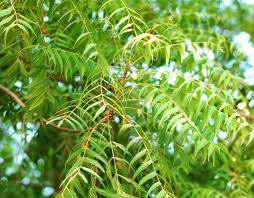 |
| Pest control, as practiced today in most developing countries relies mainly on the use of imported pesticides. This dependence has to be reduced. Although pesticides are generally profitable on direct crop returns basis, their use often leads to the contamination of terrestrial and aquatic environments, damage to beneficial insects and wild biota, accidental poisoning of humans and livestock, and the twin problems of pest resistance and resurgence. |
More than 500 arthropods pest species have become resistant to one or more insecticides. Resistance of the cotton bollworm, Helicoverpa armigera, in India and Pakistan, and of the Colorado potato beetle, Leptinotarsa decemlineata, in the USA to all available insecticides, and resistance of the diamond black moth, Plutella xylostella, to all classes of insecticides, including Bacillus thuringiensis, in Hawaii, Malaysia, the Philippines, Taiwan, and Thailand, illustrate the complexity of the problem. Shifts in pest status-from minor to major, and resurgence of pests, such as white flies, caused by direct or indirect destruction of pest's natural enemies are other unwelcome developments associated with pesticide use. |
The Neem
Botanical Name |
: |
Azadirachta indica |
Family |
: |
Meliaceae |
Subfamily |
: |
Melioideae |
Tribe |
: |
Melieae |
Common Name: Nim, Neem, Limba, and Nimba etc. |
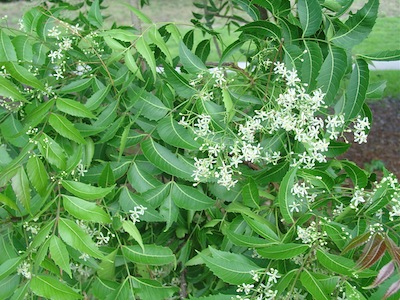 |
Neem in Pest Management
Unlike chemical insecticides, neem compounds work on the insect's hormonal system, not on the digestive or nervous system and therefore does not lead to development of resistance in future generations. These compounds belong to a general class of natural products called liminoids'. The liminoids present in neem make it a harmless and effective insecticides, pesticide, nematicide, fungicide etc. The most significant liminoids found in neem with proven ability to block insect growth are: azadirachtin, salanin, meliantriol and nimbin. Azadirachtin is currently considered as neem's main agent for controlling insects. 'It appears to cause 90% of the effect on most pests. It does not kill insects - at least not immediately - instead it both repels and disrupts their growth and reproduction. Research over the past years has shown that it is the most potent growth regulator and feeding deterrent ever assayed. It will repel or reduce the feeding of many species of pest insects as well as some nematodes. In fact, it is so potent that a mere trace of its presence prevents some insects from even touching the plants.' |
Neem extracts are known to act on various insects by:
- Disrupting or inhibiting the development of eggs, larvae or pupae.
- Blocking the moulting of larvae or nymphs
- Disrupting mating and sexual communication
- Repelling larvae and adults
- Deterring females from laying eggs
- Sterilizing adults
- Poisoning larvae and adults
- Deterring feeding
- Blocking the ability to "swallow" (that is, reducing the motility of the gut)
- Sending metamorphosis awry at various stages
- Inhibiting the formation of chitin.
|
Uses of Neem Extracts
Neem Kernel Aqueous Extract:
The simple method of Neem Kernel Aqueous Extract preparation consist of following steps –
- Take dried neem seed. Decorticate (Removal of seed coat) it with the help of mortar and pastel or any mechanical decorticate. Clean the neem kernel and seed coat mixture by winnowing seed coat.
- Weigh 1 kg of clean neem kernel and make powder of grain size like fine tea powder. It should be pounded in such a way that no oil comes out. Soak it in a about 10 lits of clean water. Add 10 ml of pH neutral adjutant (mixture of emulsifier, spreader etc.) and stir the mixture.
- Keep the mixture overnight and filter it on the next day with clean muslin cloth. Put water in the residue and repeat the extraction 2-3 times. Use residue as manure for plants.
|
Spraying of NKAE
- The spraying of 1.25% to 5% (Neem Kernel wt. Basis) of NKAE is recommended on the crops.
- The use of it is recommended as a preventive at lower concentration and protective at higher concentration i.e. up to 5 %.
- Use the spray solution on the same day.
- Spraying should be done in the low intensity of sunlight preferably in the afternoon.
- The effect of the NKAE remains for 7-10 days. Care to be taken to cover all plant foliage with NKAE.
|
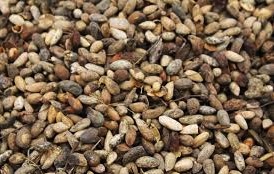 |
Neem Leaf Extract
For 5 litres of water, 1 kg of green neem leaf is required. Since the quantity of leaves required for preparation of this extract is quite high (nearly 80 kg are required for 1 hectare) this can be used for nursery and kitchen gardens. The leaves are soaked overnight in water. The next day the leaves are grounded and the extract is filtered. The extract is beneficial against leaf eating caterpillars, grubs, locusts and grasshoppers. To the extract, emulsifier is added as mentioned in kernel extract. |
Neem Cake Extract
100 gms of Neem cake is required for 1 litre of water. The Neem cake is put in a muslin pouch and soaked in water. It is soaked overnight before use in the morning. It is then filtered and emulsifier is added -1-ml for 1-litre of water. It can then be used for spraying. |
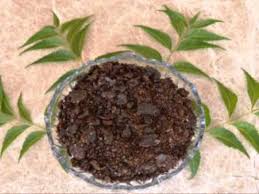 |
Neem Oil Spray
15-30 ml Neem oil is added to 1 litre of water and stirred well. To this emulsifier is added (1m1/11itre). It is very essential to add the emulsifier and mix properly. This should be used immediately before the oil droplets start floating. A knapsack sprayer is better for Neem oil spraying in preference to a hand sprayer. |
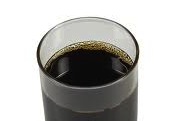 |
Precatutions for using Neem Extracts /Formulations
Spraying should be undertaken in the morning or late in the afternoon. Insects lay eggs on the underside of the leaves. Hence it is important to spray on the underside of the leaves as well.
Caution
The active principles of Neem are destroyed by:
- Heating and boiling the extract- do not boil the mixture
- Acidic or alkaline pH emulsifier- use neutral pH emulsifier
- Ultraviolet rays of sunlight - Spry during moderate sunlight,
- Hydrolysis of water- use aqueous extract on same day
Neem Against Non-Insect Pests
Research in recent years has shown that neem is quite effective against non-insect pests also.
Threadworm are among the most devastating agriculture pests. These nematodes are very difficult to control. Use of synthetic nematicides is not desirable as they cause toxicological effects. Research has shown that these pests are susceptible to neem products. Certain liminoid fractions extracted from neem kernels are providing active protection/defence against root-knot nematodes'. Water extracts of neem cake are also nematicidal. Neem cake is already being used on commercial basis by cardamom farmers in south India.
Fungi attack plants and trees in numerous ways and forms. They cause massive damage to important crops such as wheat, rice and corn. Several tests have demonstrated that neem acts as a fungicide. Should this prove widely applicable, it would have enormous positive effects on agriculture, environment and food supply with highly valuable effects like reducing poverty, increasing production etc. on a global scale. Some tests have shown unusual and promising results. Neem-leaf extracts failed to kill the fungus Aspergillus flavus but completely stopped it from producing aflatoxin'. This is important because aflatoxin is a powerful carcinogen that is causing increasing concern regarding the world's food supplies.
For protecting Stored Grains
One of the traditional uses of neem in Asia has been for controlling pests of stored products. Farmers usually mix neem leaves with grain before keeping it in storage for several months. Neem leaves, oil or extracts acts as repellent against several insects such as weevils, flour beetles, bean-seed beetles and potato moths. Treatment of jute sack by neem oil is counter-productive and prevents the penetration of pest like weevils and flour beetles. Neem oil destroys bean-seed beetles (bruchids) - a variety of insects mostly attacking legumes - at the egg-stage itself.
A mixture of neem leaves with clay and cow-dung develops pest resistant property so it can be used to make bins for storage of grain. Post harvest losses are notoriously high in developing countries. Worldwide annual losses in store reach up to 10% of all stored grain, i.e. 13 million tons of grain lost due to insects or 100 million tonnes due to failure to store properly.
While neem treatments cannot replace completely chemical pesticides used in stored products preservation, the amount of pesticides needed could be reduced, thereby decreasing the pesticide load in food grains. With proper timing and innovative methods of application, their use could be integrated in stored products management.
Neem for Soil Fertility and Fertilizer Management
Indian farmers have traditionally used de-oiled Neem cake as a fertilizer in their fields. The dual activity of Neem cake as fertilizer and pest repellent, has made it a favoured input. Neem leaves have also been used to enrich the soil. Together, they are widely used in India to fertilize cash crops. When Neem cake is ploughed into the soil it also protects plant roots from nematodes and white ants. Farmers in southern parts of India puddle neem leaves into flooded rice fields before the rice seedlings are transplanted.
Application of the Neem seed cake to crops provides them with various nutrients. Besides, the Neem seed cake also reduces the number of soil insect pests, fungi, bacteria and nematodes and protects the crop from damage caused by these organisms. Neem seed cake can also reduce alkalinity in the soil by producing organic acids when mixed with the soil.
Top
Source
N. Amruta G. Sarika, K. Sravanthi, V. Jyothi Swaroopa
Department of Agronomy, Agricultural College, Hyderabad
Department of Seed Science and technology, Bangalore
Department of Agricultural Economics, Bangalore
Updated on : Jan 2015
|





